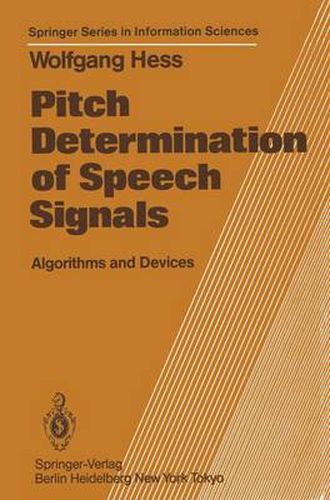Readings Newsletter
Become a Readings Member to make your shopping experience even easier.
Sign in or sign up for free!
You’re not far away from qualifying for FREE standard shipping within Australia
You’ve qualified for FREE standard shipping within Australia
The cart is loading…






This title is printed to order. This book may have been self-published. If so, we cannot guarantee the quality of the content. In the main most books will have gone through the editing process however some may not. We therefore suggest that you be aware of this before ordering this book. If in doubt check either the author or publisher’s details as we are unable to accept any returns unless they are faulty. Please contact us if you have any questions.
Pitch (i.e., fundamental frequency FO and fundamental period TO) occupies a key position in the acoustic speech signal. The prosodic information of an utterance is predominantly determined by this parameter. The ear is more sensitive to changes of fundamental frequency than to changes of other speech signal parameters by an order of magnitude. The quality of vocoded speech is essentially influenced by the quality and faultlessness of the pitch measure ment. Hence the importance of this parameter necessitates using good and reliable measurement methods. At first glance the task looks simple: one just has to detect the funda mental frequency or period of a quasi-periodic signal. For a number of reasons, however, the task of pitch determination has to be counted among the most difficult problems in speech analysis. 1) In principle, speech is a nonstationary process; the momentary position of the vocal tract may change abruptly at any time. This leads to drastic variations in the temporal structure of the signal, even between subsequent pitch periods, and assuming a quasi-periodic signal is often far from realistic. 2) Due to the flexibility of the human vocal tract and the wide variety of voices, there exist a multitude of possible temporal structures. Narrow-band formants at low harmonics (especially at the second or third harmonic) are an additional source of difficulty. 3) For an arbitrary speech signal uttered by an unknown speaker, the fundamental frequency can vary over a range of almost four octaves (50 to 800 Hz).
$9.00 standard shipping within Australia
FREE standard shipping within Australia for orders over $100.00
Express & International shipping calculated at checkout
This title is printed to order. This book may have been self-published. If so, we cannot guarantee the quality of the content. In the main most books will have gone through the editing process however some may not. We therefore suggest that you be aware of this before ordering this book. If in doubt check either the author or publisher’s details as we are unable to accept any returns unless they are faulty. Please contact us if you have any questions.
Pitch (i.e., fundamental frequency FO and fundamental period TO) occupies a key position in the acoustic speech signal. The prosodic information of an utterance is predominantly determined by this parameter. The ear is more sensitive to changes of fundamental frequency than to changes of other speech signal parameters by an order of magnitude. The quality of vocoded speech is essentially influenced by the quality and faultlessness of the pitch measure ment. Hence the importance of this parameter necessitates using good and reliable measurement methods. At first glance the task looks simple: one just has to detect the funda mental frequency or period of a quasi-periodic signal. For a number of reasons, however, the task of pitch determination has to be counted among the most difficult problems in speech analysis. 1) In principle, speech is a nonstationary process; the momentary position of the vocal tract may change abruptly at any time. This leads to drastic variations in the temporal structure of the signal, even between subsequent pitch periods, and assuming a quasi-periodic signal is often far from realistic. 2) Due to the flexibility of the human vocal tract and the wide variety of voices, there exist a multitude of possible temporal structures. Narrow-band formants at low harmonics (especially at the second or third harmonic) are an additional source of difficulty. 3) For an arbitrary speech signal uttered by an unknown speaker, the fundamental frequency can vary over a range of almost four octaves (50 to 800 Hz).